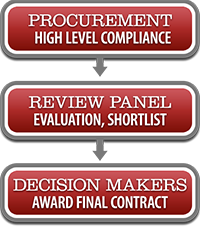Strategy: Insights into Pitching to Government
Government evaluation panels sink hours into reading our tender submissions. What impresses them about a response? And what turns them off? We peek behind the curtain.
KEY POINTS
- Government Panels Favour Tenders that Offer Clear 'Value for Money'
- Being Brief and Crystal Clear Gets Panels On-Side
- Shortlisted Tenders are Compliant and Specifically Address Evaluation Criteria
- Winning Tenders are all about Common Sense and Best Practice
- If Lacking Capacity or Capability, Consider Using an Expert
Some time ago, we enjoyed an audience with a city councillor. This seasoned public servant has served on evaluation panels for years. And he's seen the complete submission spectrum: the good, the bad and the painfully ugly.
His insights from the other side of the tendering table were frank, honest and insightful. And the principles hold true whether you are pitching to Local, State or Federal government. Bearing them in mind may help you to win more often.
1. Focus on Value, Not Price
According to our source, a recent internal review revealed that cost was the deciding factor in only one sixth of awarded contracts. In fact, "Value for Money" was much more decisive. With budget already allocated for the goods or services, panels favour tenderers who offer value-added extras that either benefit the local community or make the council's job easier.
The Implications for Your Responses?
Maximising your offer's perceived value for money relies on an accurate understanding of both the prospect's needs, and your capabilities. While a focused workshop will often tease out winning themes that highlight added value, all tenderers should ask:
- Do your goods and services have a tangible point of difference that will satisfy prospect needs?
- Can you exceed the requirements of the tender - at little or no extra cost?
- Can you include valuable additional services as part of the offer price?
- Do you have innovative systems, tools or approaches that will make the prospect's life easier during the life of the contract?
- Can you provide something that will bring tangible benefits to the community?
Going 'beyond the brief' by offering benefit-laden extras is the fast-track to raising your value-for-money scores.
2. Avoid the 'Read Later Pile'
Evaluators have a tough job. For popular tenders, they will often wade through thousands of pages to arrive at a shortlist. Perhaps unsurprisingly, panelists will cast lengthy, wordy, or otherwise impenetrable submissions into the 'Read Later Pile' so they can move on to clearer, more succinct responses. Often left until last, occasionally these submissions are only skimmed in order to reject them, the decision already made. Hardly the way to put your best tender foot forward.
The Implications for Your Responses?
Long, complex sentences and huge slabs of text hamper clear reader comprehension. We often tell clients: "The writing is in the re-writing". Highly focused edits will result in punchy, pithy writing that is a joy to read and a cinch to navigate. Trimming fat and leaving muscle is the key. Tender Writing is a niche skill, so consider having an experienced tender writer edit and finish your raw content for you.
Using professionally-designed pictures, tables and graphics will bring text to life and ease eyestrain. And the clear inclusion of only relevant attachments will result in a slicker, more readable response package.
3. Compliance is King
Highly competitive RFTs generate a staggering number of responses. In order to rate them - and to cull the pack - they will typically pass through three government filters:

- Stage 1: A procurement officer assesses the responses for compliance with the issued RFT and associated policies. Failure at this point means a response is rejected without its content being assessed.
- Stage 2: An evaluation panel will review the response and score it according to evaluation criteria weightings. Only the highest rated responses are passed through to the decision-makers, so this is where adding value will score you highly and help you stand out from the pack.
- Stage 3: A final evaluation and discussion of the shortlist is made, the responses are scored and a contract is awarded.
The Implications for Your Responses?
The shortlist only contains compliant responses that satisfy the requirements of RFT. Your responses should be designed from the ground up with this in mind.
- Maintain a Compliance Checklist: During your initial analysis of the RFT - and as you develop your response - maintain a compliance checklist identifying the essential inclusions. This will insure that essential information, inclusions and document length and format won't make you fall at the first hurdle. Oh, and remember: government cannot accept late tenders.
- Stick to the Evaluation Criteria: Most RFTs have stated Evaluation Criteria. An evaluation panel will only score a response highly if they can clearly see how the offer satisfies their stated needs. Make their job easy. Quoting directly from the RFT and answering questions clearly will demonstrate you're speaking the same language. And if your proposal DOES contain elements that differ from the RFT (e.g. non-compliant clauses), ensure these are explained with crystal clarity.
Perhaps these collected insights aren't so surprising. After all, they reflect both common sense and tendering best practice. However according to our source, many responses he has reviewed reflect little of these. This is perhaps the most valuable insight of all. The potential for tenderers to improve their win rate is clearly huge. And using these principles - or hiring experts to strengthen your capabilities - can mean winning more government tenders, more often.
 Matt Milgrom is a senior consultant for Tender Success. Tender Success offers considerable insights to companies interested in raising their win rate to Government agencies. Contact Matt to strengthen your next submission to government.
Matt Milgrom is a senior consultant for Tender Success. Tender Success offers considerable insights to companies interested in raising their win rate to Government agencies. Contact Matt to strengthen your next submission to government.



